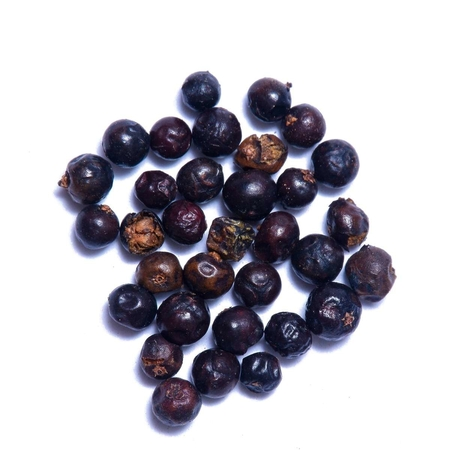





Botanical name Phoenicean juniper
Family Cupressaceae
Source Berries
Origin India
Processing Method Steam Distillation
Color/Consistency A thin, colorless to pale yellow liquid.
Aromatic Summary / Note / Strength of Aroma A middle note with a medium aroma, Juniper Berry has a fresh, rich, balsamic scent reminiscent of pine needles.
Blends With Eucalyptus, Chamomile, Rosemary, Marjoram, Geranium, Bergamot, Sandalwood and Clary sage.
Product Abstract
Juniper berries of the leaves have been used since ancient times for medicinal and spiritual purposes. The leaves woody twigs emit a lemon- or apple-like fragrance when crushed. Juniper berry essential oil obtains from the fresh or dried berries and needles by steam distillation. Terpineol, terpinene and pinene are three of the major constituents of juniper berry essential oil and are the reason why it can be helpful in treating skin infections and other health issues.It can also help soothe skin flair-ups, boost the immune system, help with insomnia and aid with digestion. It has high antioxidants so it fights against free radical damage.
History
Juniper berries, including Juniperus phoenicea and junipers oxycedrus have been found in ancient Egyptian tombs at multiple sites. J. oxycedrus is not known to grow in Egypt, and neither is juniperus excelsa, which was found along with J. oxycedrus in the tomb of tutankhamun.The berries imported into Egypt may have come from Greece; the Greeks record using juniper berries as a medicine long before mentioning their use in food.
Harvesting/Extraction Information
The berries are green when young, and mature to a purple-black color over about 18 months. The berries are plucked from the branches of the plant once a year, and dried and ground before distillation. They have traditionally been used as an aromatic aid to meditation, and had remedial applications.
Common Usage
Caution
It should be avoided during pregnancy and by those who have kidney problems, and it should always be used in low concentrations.
Key constituents
a-Pinene 41.8–53.5%
Manoyl oxide tr–14.4%
b-Phellandrene 3.5–5.9%
(þ)-Limonene tr–4.7%
a-Terpinyl acetate 0–4.6%
b-Myrcene 4.0–4.5%
Isopulegyl acetate 0–3.3%
b-Pinene 1.3–2.5%
a-Terpineol 0.8–2.5%
1-epi-Cubenol 0–2.3%
Linalyl acetate 0–2.0%
d-3-Carene 0–1.7%
Isopulegol tr–1.6%
Terpinolene 0.6–1.3%
Linalool 0.7–1.3%
d-Cadinene tr–1.3%
Terpinen-4-ol tr–1.3%
Elemol 0–1.2%
b-Caryophyllene 0.5–1.0%
Safety summary
Hazards Skin sensitization if oxidized.
Cautions Old or oxidized oils should be avoided.
Our safety advice
Because of its high a-pinene content we recommend that oxidation of Phoenician juniper oil is avoided by storage in a dark, airtight container in a refrigerator. The addition of an antioxidant to preparations containing it is recommended.
Organ-specific effects
Adverse skin reactions Undiluted Phoenician juniper oil was moderately irritating to rabbits; tested at 1% on 25 volunteers it was neither irritating nor sensitizing. No phototoxic effects were produced in mice or swine. Autoxidation products of a-pinene can cause skin sensitization.
Systemic effects
Acute toxicity Phoenician juniper oil acute oral LD50 in rats >5 g/kg; acute dermal LD50 in rabbits >5 g/kg.
Carcinogenic/anticarcinogenic potential No information was found for Phoenician juniper oil, but it contains no known carcinogens.
Comments
Phoenician juniper oil is sometimes confused with savin oil.